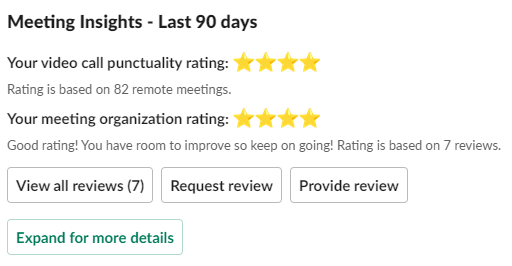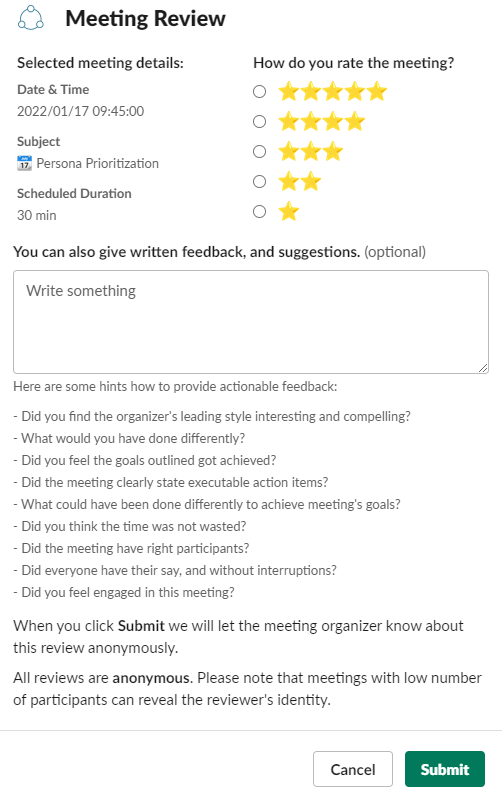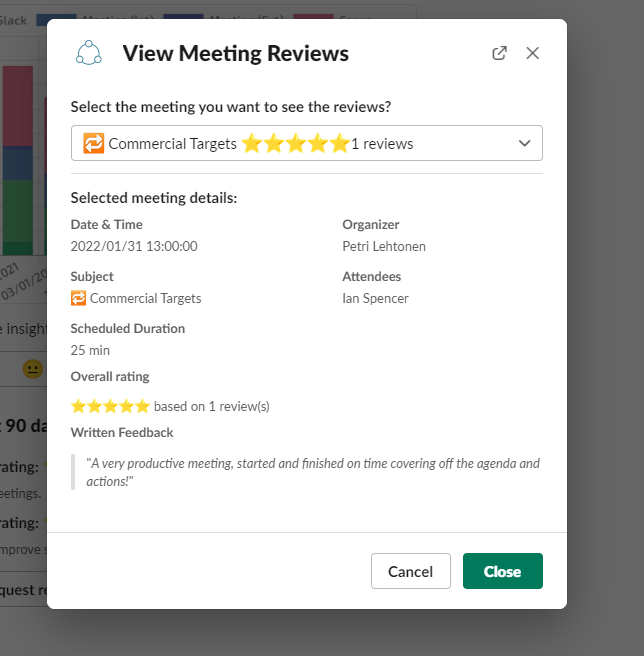Managers know that meeting feedback is important, but it's not always easy to collect. Feedback can be vague and unhelpful, or it can be so specific that it's difficult to take action on. In this blog post, we'll discuss a few tips for collecting feedback that's both useful and actionable. By following these tips, you'll be able to improve your meetings and make them more productive for everyone involved!
WHY SHOULD YOU COLLECT MEETING FEEDBACK?
Before you start collecting feedback, it's important to understand why you want to collect it in the first place. Are you looking for ways to improve the meeting itself, or are you trying to figure out how well your team is performing? Different types of feedback will be more useful depending on your goals.
If you're looking to improve the meeting itself, then feedback about the agenda, structure, and topics covered can be helpful. If you're trying to assess team performance, then feedback about participation levels, discussion quality, and decision-making processes can be more useful.
How to Collect Meeting Feedback

Collecting meeting feedback can be a challenge, but it's important to do if you want to improve your meetings. Here are a few tips for collecting feedback that's both useful and actionable:
- Make sure the questions are clear and concise. Don't ask leading questions or make assumptions about what people think. Be specific about what you want feedback on.
- Ask for specific examples. Don't just ask people to give general feedback - ask them to give specific examples of things that went well and things that could be improved.
- Don't forget to follow up. After you've collected feedback, make sure you actually do something with it! Follow up with people who gave feedback to make sure their suggestions were taken into account.
Using Anonymous Meeting Feedback Forms
If you want to collect feedback from a large number of people, anonymous meeting feedback forms can be a great way to do it. Meeting feedback forms can be used to collect both positive and negative feedback, and they can help you get a better understanding of how your meetings are perceived by others.

Make sure the questions on the form are clear and concise, and make sure there's a space for people to write in their own comments. You may also want to include some demographic information (such as job title or department) so that you can see if any patterns emerge.
Collecting Post Meeting Feedback
It's important to collect meeting feedback after every important meeting - not just when you're trying to improve the meeting itself. By collecting post-meeting feedback, you can get a better understanding of how well the meeting went and what could be improved.
Ask participants to give feedback about the meeting within 24 hours of the end of the meeting. This will help ensure that they have a clear recollection of what happened.
Make sure to ask specific questions about the meeting, such as how well it was organized, how effectively people participated, and whether decisions were made.
Once you've collected feedback, it's important to follow up with those who gave it. This will show that you're taking their suggestions seriously and that you value their input.
Follow up with respondents within one week of receiving their feedback. Thank them for their time and let them know what actions were taken in response to their suggestions.

Trends to Look for In Meeting Feedback
By collecting meeting feedback, you can start to see patterns in how well your meetings are performing. Here are a few trends to look for:
- Did the meeting start on time, and achieve its set goals?
- Are people participating equally?
- Do people feel like they're able to contribute?
- Are decisions being made effectively?
- Is the discussion quality high?
- Are there any topics that keep coming up again?
- Are people leaving the meeting feeling energized?
By looking for these trends, you can start to identify areas where your meetings could use some improvement.
Importance of Collecting Meeting Feedback for Large Sessions

If you're responsible for organising a large meeting - or if you're simply attending one - it's important to collect feedback after the meeting has ended. This will help you understand how well the meeting went and identify any areas that need improvement.
Collecting feedback can be difficult when there are hundreds of people involved, but there are a few ways to make it easier:
Use online survey tools like SurveyMonkey or Google Forms to collect feedback from all participants simultaneously.
Distribute a paper questionnaire at the end of the meeting and ask people to return it within 24 hours.
Send out an email survey after the meeting has ended. Make sure to include a space for comments so that people can provide more detailed feedback.
Collecting Meeting Feedback - Importance of Punctuality
One challenge that can arise in any meeting is when one or more participants are not on time. This can disrupt the flow of the meeting and impact its effectiveness. Meetings that start on time are more productive and allow everyone to have their say. However, not only must they start on time, but they must also have a structured and well-planned agenda.

Punctuality for meetings is an important standard for any meeting, but even more so for large meetings. Attendees that are late in large meetings can have a huge impact financially on the company. Just from meetings starting 5 minutes late every week, it could lead to the company losing thousands. It is actually estimated that $37 billion is lost every year, with punctuality being partly to blame.
Meeting punctuality cost example: 50 employee company, average salary of £45k, 1'800 working hours per year, with 250 weekly meetings on average. An average meeting time of 50 minutes, 4 internal attendees, and starting 5 minutes late:
83 hours * 52 weeks * £45'000 / 1'800h = £108'300 losses of effective working hours
In order for a meeting to start on time, the agenda must be well-planned and everyone involved should be familiar with it. If there are any changes to the agenda, they should be announced before the meeting starts.
Using Flowtrace for Meeting Feedback
If you're looking for a way to collect automatic punctuality feedback, or anonymous meeting feedback that's both concise and actionable, Flowtrace may be the solution for you. Flowtrace is a meeting culture analysis and improvement tool that helps you understand how people are interacting during meetings. Read more about our meeting culture solution from here.
With Flowtrace, you can:
- Empower every meeting organizer and attendee to feedback their meetings.
- Identify punctuality and qualitative issues on meetings.
- Get actionable suggestions how to improve your meetings, and meeting culture.
Flowtrace also includes a built-in feedback form so that you can collect feedback from participants after the meeting has ended. This feedback can help you identify areas where the meeting could be improved.

Conclusion
Collecting meeting feedback is an important part of organising and participating in meetings. By using the right tools and asking the right questions, you can collect feedback that's both concise and actionable. And by following up with respondents, you can show that you're taking their suggestions seriously and value their input.